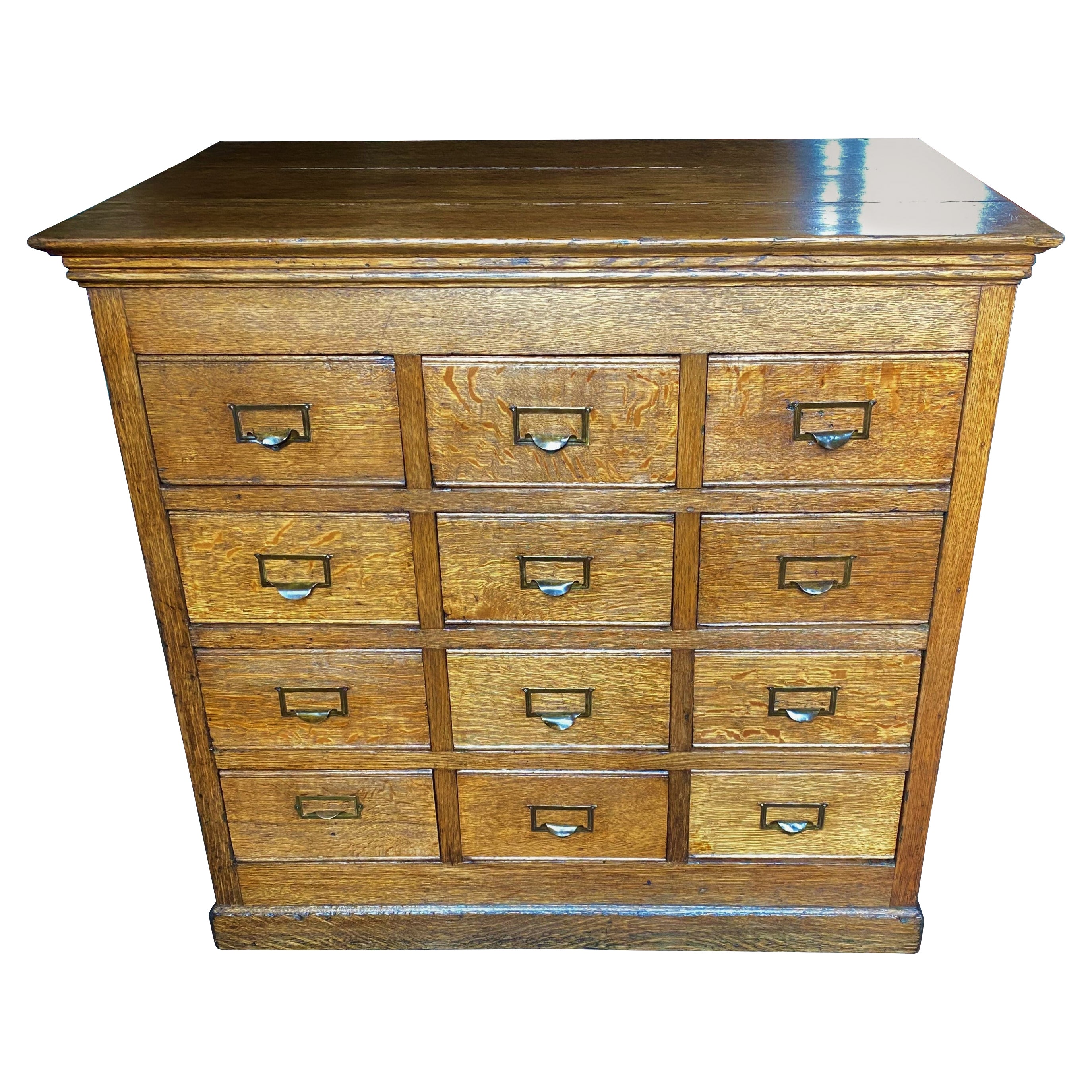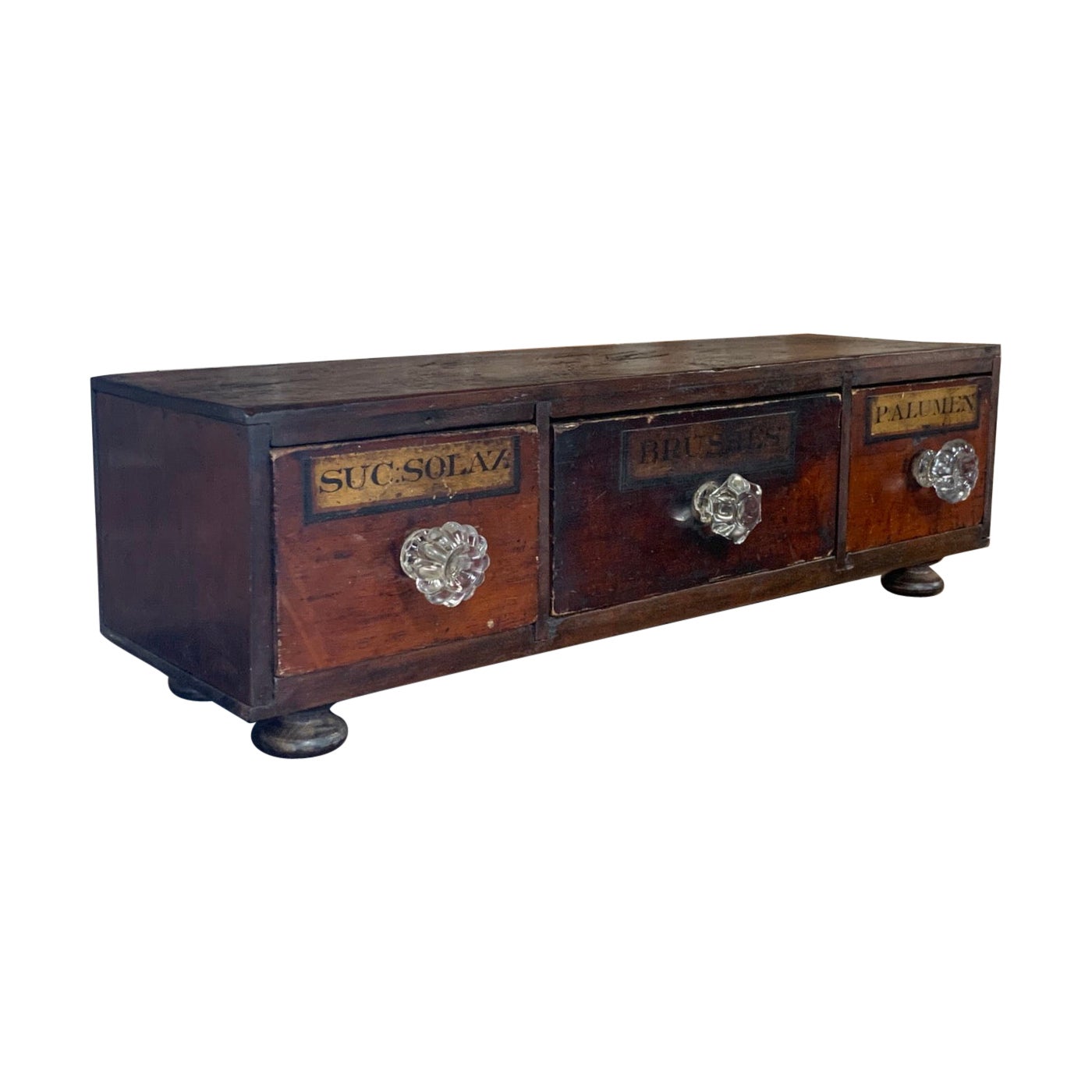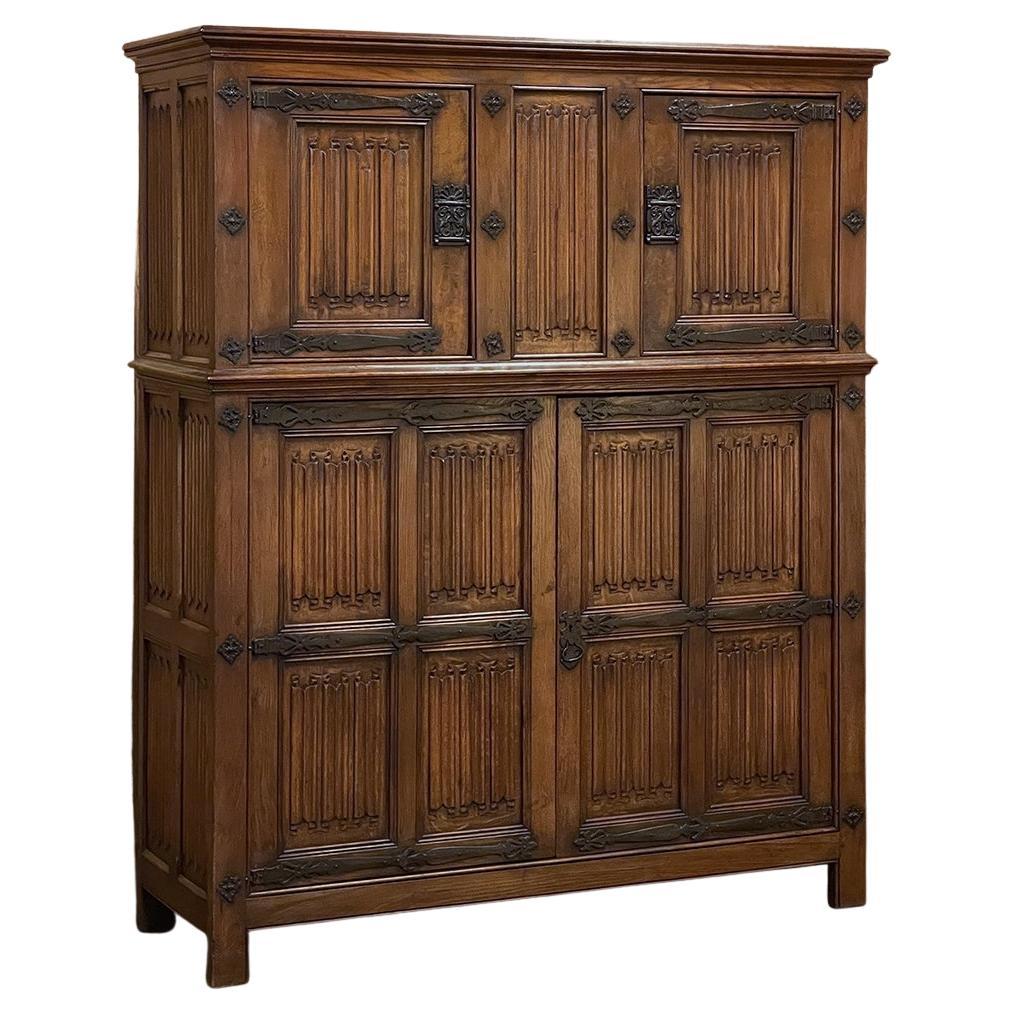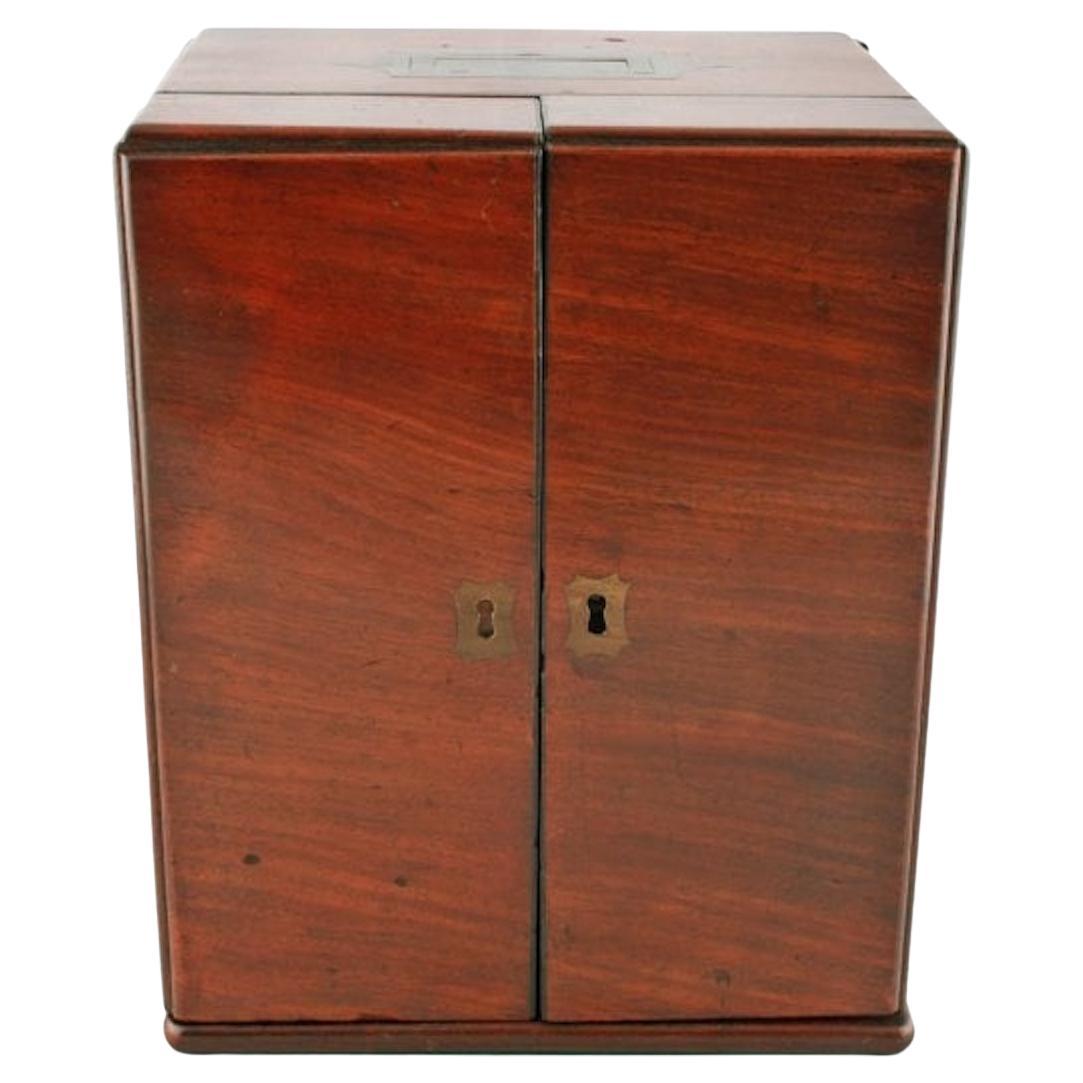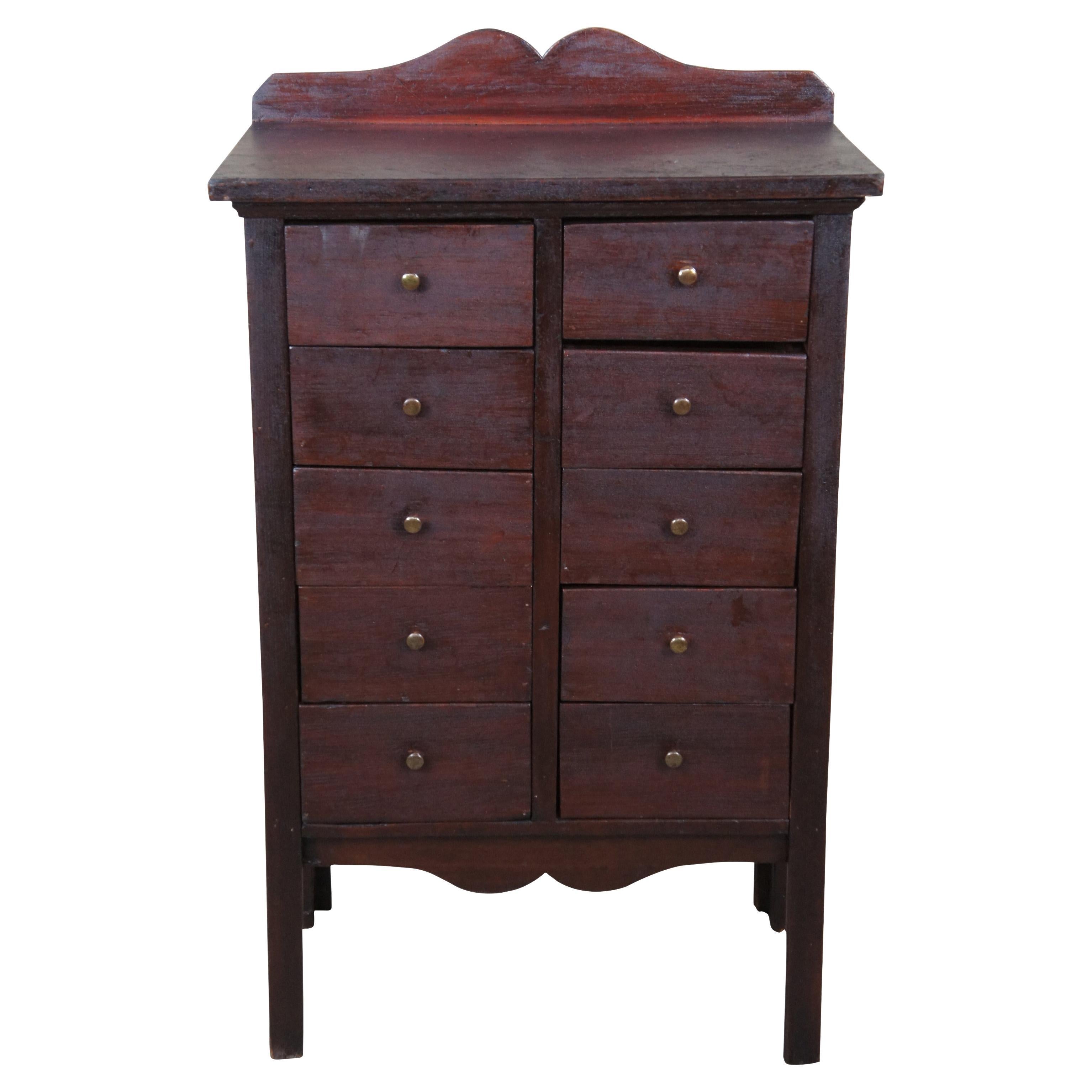Items Similar to Gothic Revival Apothecary Cabinet
Want more images or videos?
Request additional images or videos from the seller
1 of 5
Gothic Revival Apothecary Cabinet
About the Item
Wooden apothecary cabinet with carved decoration in neo-Gothic style. The capitals are carved with Baphomets holding two figures by the hair for one and fantastic birds for the other.
Idol worshiped by the Knights of the Order of the Temple, most often represented by the head of a bearded man - but not only. The Templars at the fall of the Latin States of the East in 1291, went into exile in France and represented a powerful military and financial force in the face of royal power weakened by debt.
They have also been accused of apostasy for having in the East denied Christ and worshiped Baphomet but also, according to one of the many interpretations, it is a code name meaning wisdom.
- Dimensions:Height: 69.69 in (177 cm)Width: 65.75 in (167 cm)Depth: 23.63 in (60 cm)
- Style:Gothic Revival (Of the Period)
- Materials and Techniques:
- Place of Origin:
- Period:
- Date of Manufacture:circa 1900
- Condition:
- Seller Location:Saint-Ouen, FR
- Reference Number:1stDibs: LU3115327312642
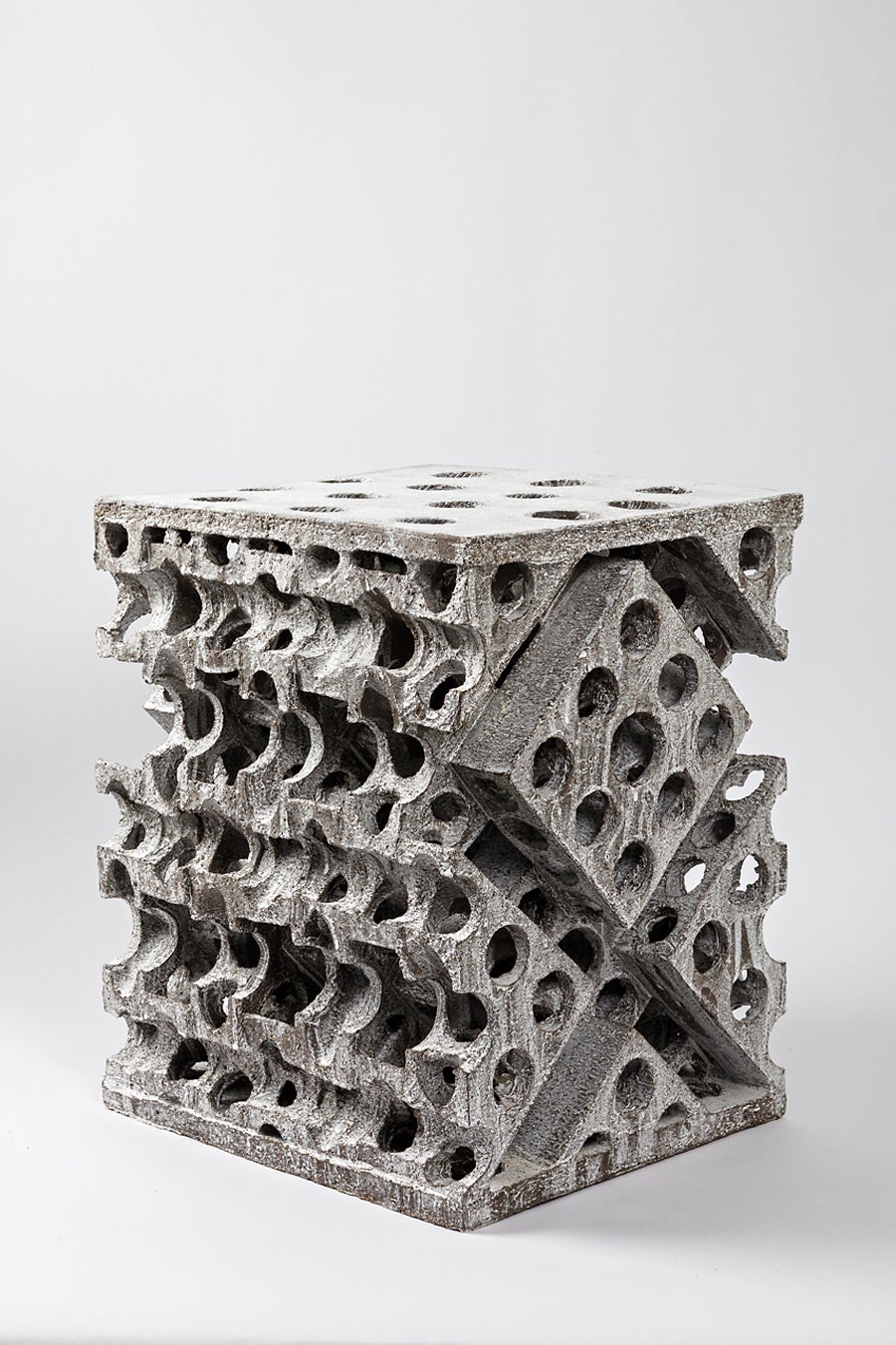
About the Seller
5.0
Vetted Seller
These experienced sellers undergo a comprehensive evaluation by our team of in-house experts.
Established in 2016
1stDibs seller since 2017
147 sales on 1stDibs
Typical response time: 8 hours
- ShippingRetrieving quote...Ships From: Saint-Ouen, France
- Return PolicyThis item cannot be returned.
More From This SellerView All
- French Renaissance Cabinet with PerspectivesLocated in Saint-Ouen, FRThis Renaissance Cabinet reveals the great mastery of the Lyon workshops which are at the origin of its realization. Sculptors and wood-carvers worked here in symbiosis to express an...Category
Antique 16th Century French Renaissance Cabinets
MaterialsWalnut
- Important Renaissance Cabinet from Lyon 'France' with a Decor of PerspectivesLocated in Saint-Ouen, FRAs soon as 1540 France's second Renaissance is in the making, intimately linked to the rediscovery of the Antique world. The development of the printing and engraving industry allows the spread of artworks and models in many cities and countries. The Italian influence can be perceived in every artistic field. While the French king entrust the most talented Italian artists with major projects such as Il Rosso or Primaticcio in Fontainebleau, French artists also travel to Italy to form themselves to this new style. In Italy they get acquainted with the work of Leo Battista Alberti the first to theorize perspective (De Pictura, 1435-36) and architecture (De re oedificatoria, 1541). Those two publications would have a revolutionary impact on arts. Furniture is marked by the work of the most famous Italian architects of the time as well as French architects. Indeed Philibert de l'Orme competes with Alberti and by the end of his life publishes several treaties including one devoted to a theory of architecture (1567). Unfortunately he would not live to complete the second volume. In this treaty he expresses his interest for mathematical norms applied to architecture, copied from the Antique. His journeys in Italy allowed him to accumulate the most sophisticated references. Jean Bullant, another architect of great talent also theorizes his practice. He establishes rules characterizing Greco-Roman art staying faithful to Vitruvius. Following this new inspiration the structure of furniture evolves. From then on appear columns, capitals, cornices, friezes and architraves. The ornamentation uses this inspiration as well with egg-and-dart, palm leaf and rose adorning the most beautiful pieces. In Lyon, crossroad where meet merchants from everywhere those new experiments are welcomed. Lyon florishing printing industry allows the spreading of models and treaties essential to the artist's work. Thus the first publication of Vitruvius' De Architectura in France would be printed in Lyon in 1532. Artists from Lyon rediscover and familiarize themselves with the Antique knowledge very early. They adopt those new ideas and use them in their own creations. Lyon cabinet-makers re interpret Antique architecture and Italian Renaissance palaces to give their pieces a pure and harmonious architectural structure. Grooved pilasters are particularly favored. They are topped by capitals of diverse orders always respecting the sequencing with simpler ones for the lower levels and the richest ones on the higher levels. As for the ornamentation, one of the great distinctiveness of Lyon workshops remains the architectural perspective illusions, drawing inspiration from Tuscany. True masterpiece of the Second French Renaissance this important cabinet illustrates Lyon workshops' taste for fine Italian architecture inspired by Antiquity. An architectural perspective of great quality is treated in symmetry on each panel. This two-bodied cabinet without recess stands on four rectangular feet. The base comprises a molding, a palm leaf frieze and is bordered by a braid. The lower body is divided by three grooved pilasters with Tuscan capitals framing two door-leaves. The two panels are encircled by a moudled frame with palm leaves. They are finely carved with a decor of fantasized architecture depicting an Italian Renaissance palace erected symmetrically on each side of a grooved pilaster. On the ground floor a door opens through a stilted arch while the stories are opened with mullioned windows, dormers and occuli. Two large pegged-boss cladded pillars support the entablature enriched by a palm leaf frieze upon which stands an arch whose coffered intrados is centred by a rose. Behind this arch a pyramid appears, standing in front of a second facade with a window topped by a broken curvilinear pediment under a cul-de-four with a shell. The checker flooring gives depth to the low-reliefs creating vanishing points structuring the panels and guiding the eye of the observer. A thin laurel braid highlights the belt of the cabinet where are located two drawers. Their facades are adorned by palm leaves in hoops. The upper body is encircled with palm leaves. The same ternary division as in the lower body appears. However, the pilasters are topped by Ionic capitals with volutes and egg-and-dart. The door-leaves are framed with flowers. On the panels the artist has designed another architectural decor. On the foreground open two arches on top of grooved pilasters with rectangular capitals adorned with palm leaves. The arches are enriched with braids and the coffered intrados bears a decor of roses. The spandrels also bear a flower decor. In the background another arcature hosts a fluted grooved column topped with double basket acanthus capital, characteristic of Corinthian order. The triangular pediment is interrupted by a choux bourguignon. A large cornice crowns the cabinet. It stands on pilasters and forms an entablature comprising a palm leaf frieze and an egg-and-dart, triglyph and palm leaf cornice. The cabinet's sides have also been carefully considered. The lower body's panels are enriched with an arch rising above a broken pediment portico hosting a twisted column. Flowers garnish the spandrels. An architectural facade completes the decor. The upper body's panels present two arches supported by a facade opened with dormers and mullioned windows as well as cartouches (one bears the inscription 1580 dating the cabinet) suggesting the interior of an Italian Renaissance palace, confirmed by the chandeliers. The flooring leads our gaze to a second arch with a broken curvilinear pediment where stands a flower vase. This arch opens onto a perspective of another facade along a road. Inside the cabinet, on the lower body door-leaves appear two designs. On the right door is depicted a Crucifixion. Saint Mary and Saint John flank the Christ on the cross. In the bottom part is inscribed « Dure uiator abis nihil haec spectacula curas / Pendenti cum sis unica cura Deo. / Tota suo moriente dolet natura Magistro. / Nil qui solus eras caussa dolenda doles. ». The signature [Christoff Swartz Monachiensis pinx[it] / Ioa[nnes] Sadeler sculp[it]] tells us it was made by Johan Sadeler I (1550-1600) after Christoph Schwartz (1548-1592). This engraving belongs to an ensemble depicting the Passion of Christ Johan Sadeler executed in 1589 after an altar piece painted by Christoph Schwartz for the private chapel of Renée of Loraine, wife of Duke William V of Bavaria. This altar piece made of nine copper panels has been destroyed during the 19th century. The Crucifixion panel once in the centre of the altar piece is the only one that survived and is today kept in Munich's Alte Pinakothek. On the left door appears Saint Francis receiving the stigmata. The inscription says : « Signastidomine Servum Tuum. Franciscum. Signis Redemptionis Nostrae ». This Renaissance cabinet with an architectural decor appearing as much in the structure faithful to Antique rules...Category
Antique 16th Century European Renaissance Cabinets
MaterialsWalnut
- 16th Century Cabinet with Knights Carving from Avignon Workshops 'France'Located in Saint-Ouen, FRCollection Jean Thuile Around the mid-sixteenth century French furnishing evolves in its conception and ornamentation. The start of major archi...Category
Antique 16th Century French Renaissance Cabinets
MaterialsWalnut
- 17th Century Emblazoned Germanic ArmoireLocated in Saint-Ouen, FRThis interesting oak cabinet of germanic workmanship is a wedding furniture. The cabinet rests on a molded base, opens with two doors located on e...Category
Antique 17th Century German Other Wardrobes and Armoires
MaterialsOak
- Renaissance Palace Wardrobe with Perspectival ViewsLocated in Saint-Ouen, FRA rare carved walnut wardrobe opening with four door-leaves and two drawers in the lower part. The doors bear architectural views in low reliefs, fluted pilasters and Ionic capitals. Upper Body Two door-leaves with carved architectural perspectives open the wardrobe framed by three fluted pilasters with Ionic capitals. Each door-leaf depict two semi-circular arcades whose cornice and base shows a central vanishing point. Likewise the pavement’s lines act for the artisan as a way to create depth. The vaulting instead leads us to think the vanishing point has to be situated where the handle is, between the two complementaries reliefs. The elegant moulded belt hides an internal secret space, accessible through a moveable plank in the upper body. Lower Body Two door-leaves identical to those of the upper body framed by three fluted pilasters with Doric capitals. The base of the wardrobe opens with two large drawers. The sides also bear panels depicting architectural perspectives. The external pilasters share their Ionic capital with the facade’s pilasters. Thus we can observe on the wardrobe’s sides the capital’s lateral parts with the elegant volute specific to the Ionic order. This palace wardrobe is topped by an overlapping cornice standing on three consoles for the facade and two consoles on each sides. Placed right above the pilasters each console are adorned by fully expanded leaves. During the 15th century a major interest for architecture and perspective studies arises and influences patrons tastes. The work of great theorists such as Leon Battista Alberti...Category
Antique 16th Century Italian Renaissance Wardrobes and Armoires
MaterialsWalnut
- French Renaissance ArmoireLocated in Saint-Ouen, FROriginal lock and key This piece of furniture shows no recess on its upper part. It opens with four folding-doors and two drawers within the belt. The key bears the date 1524 above cross motifs. Burgundy and Lyon regions subordinated themselves to architecture in a different manner than the other french schools. Rather than using particularly columns and pediments pieces of furniture from Lyon borrow architecture’s organization principles and rigorous designs. On the upper body a strong feeling of balance and symmetry appears with the folding doors reliefs. Swags of flowers and fruits held with knot cloth centered by a man seating on his arms. Here profiles, masks and chou de Bourgogne mingle with the structuring scrolls. The two lateral terms wear draperies and the goddess Diana in the center wears a belt of fruits similar to Hugue Sambin’s designs (Termes de Diane et de Venus, 1554, BNF). The two palm-leaves enriched drawers and the alternating scrolls belt balance the weight of the cornice with its alternatings consoles and tops. The lower body is also adorned by three terms with a feminine one in the center, all three are wearing fruits on their heads. The folding doors are centered upon a motif of cut cuirs by a mask in high relief. Wearing a feathered tiara...Category
Antique 16th Century French Renaissance Wardrobes and Armoires
MaterialsWalnut
You May Also Like
- Vintage Apothecary CabinetLocated in Oakville, CTMulti-drawer cabinet Overall dimensions: 27" x 41" x 39" high Drawer size: 10" x 23 1/2" x 5" high.Category
Early 20th Century American Cabinets
MaterialsBrass
- 19th Century Apothecary CabinetLocated in Ongar, GBA nice small set of 19th century apothecary drawers with original labels and glass handles. In a purpose made cabinet.Category
Antique 19th Century British Apothecary Cabinets
MaterialsMahogany
- Antique French Gothic Wardrobe, CabinetLocated in Dallas, TXAntique French Gothic wardrobe ~ cabinet is an intriguing example of the style, with no less than 23 hand-carved linenfold panels combining with ...Category
Early 20th Century French Gothic Revival Wardrobes and Armoires
MaterialsIron
- Apothecary Cabinet, circa 1800Located in Southall, GBGeorge III Apothecary cabinet A George III mahogany apothecary cabinet. The box has a brass military late handle set in the top and comprises a pair of doors that open and have space for six bottles. The interior can hold four bottles and has two drawers, one for scales and the other to hold small bottles and other equipment. To the rear of the box is a locked compartment with a sliding door designed to hold four bottles which could have been poisonous. The box is in good condition but is missing some bottles. (Circa 1800...Category
Antique 18th Century English Apothecary Cabinets
MaterialsMahogany
- 20th Century Victorian Revival Pine Apothecary Cabinet Side End Table ChestLocated in Dayton, OHVintage Apothecary cabinet or chest, circa 1940s. Made from pine with a mahogany color stain. Features a rectangular form with serpentine cu...Category
Vintage 1940s Victorian Commodes and Chests of Drawers
MaterialsPine
- French Oak Apothecary Cabinet / Filing Cabinet, 1930sLocated in Nijmegen, NLThis apothecary / filing cabinet was produced during the 1920/30s in France. It features 16 drawers from oak with brass pulls. The interior dimensions of the drawers are: D x W x H 3...Category
Vintage 1930s French Art Deco Apothecary Cabinets
MaterialsOak
Recently Viewed
View AllMore Ways To Browse
Antique Revival
Antique Revivals
Antique Revival Furniture
Gothic Furniture Used
Gothic Gothic
Antique Gothic
Antique Gothic Furniture
Antique Gothic Furniture Furniture
Gothic Furniture Antique
Antique Furniture Gothic
Gothic Antique Furniture
Gothic Revival Antique Furniture
Early Gothic
20th Century Gothic
Revival Carved Cabinet
Antique Gothic Cabinet
Gothic Revival Carved
Gothic A Cabinet
